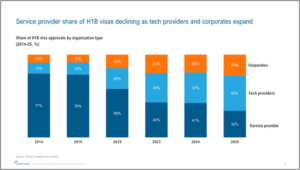Outlook: low likelihood of passage, high visibility of risk
It is important to stress that the probability of these proposals becoming law in the immediate future is relatively low, whereas the political and public visibility is high. The HIRE Act, for instance, faces steep opposition and complexity. Critics argue it could hurt business competitiveness and raise consumer costs, and it would require significant new regulations to implement. As of now, it remains in committee, with any effective date likely pushed out if it progresses. The Keep Call Centers in America Act, despite bipartisan sponsorship, would need to pass both houses and would only take effect a year after enactment even if adopted.
However, the issue has entered the mainstream debate, which means executive teams and boards are increasingly aware of it. Media coverage and political sound bites (e.g., slogans like “Make Call Centers American Again”) have elevated negative sentiment for offshoring. Stakeholders will expect management to have a position and contingency plan. Indeed, some corporate leaders report fielding questions from board members on impact and readiness.
Bottom line: While an actual 25% service tariff or an enforced call center repatriation mandate may never materialize, the signal is clear, companies reliant on global service delivery should not dismiss the chatter outright. The prudent stance is to treat this as a risk factor to monitor and prepare for, rather than an imminent operational change. In risk management parlance, this is a low-likelihood, high-impact scenario, and one that carries reputational and business continuity implications even if it remains just a proposal.

